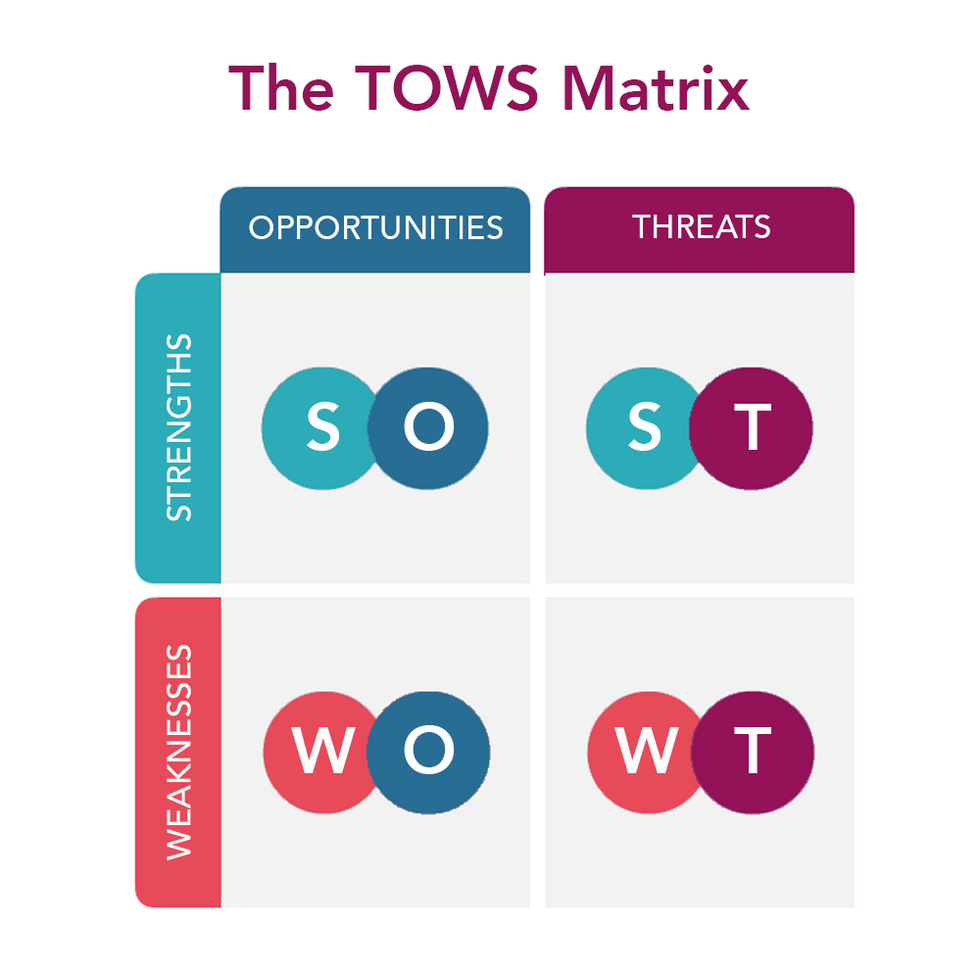
What if I were to tell you that you might be doing the good old SWOT analysis incorrectly?
And on top of that, you’re only doing half of it?
SWOT: Strengths, Weaknesses, Opportunities, and Threatsâa classic framework familiar to many in the business world. Itâs often used as a situational analysis for an organizationâs strategic planning.
The SWOT is so common that its usage, in some cases, has morphed from its original form. This results in an analysis that is only partially complete. And rarely helpful.
It also has a whole other halfâthe TOWS analysisâwhich is where your SWOT goes from âI made a listâ to a practical, actionable strategy.
Here are the most common steps that we get wrong when completing a SWOT.
âI Just List My Companyâs Strengths, Weaknesses, Opportunities, And Threats, Right?â
Wellâ¦kind of.
Many people get the Strengths and Weaknesses correct. Indeed, you simply list out your companyâs areas of mastery and shortcomings.
However, the Opportunities and Threats sections are where most people make their first SWOT mistake.
The O and T are NOT specifically about your company.
O and T are to be lists of EXTERNAL factors that could affect your business. In other words, things that in most cases are beyond your direct control.
Hereâs a simple example. Let’s say you are running a food cart that sells pie⦠because…pie! As I’m a native Midwesterner, it has to be pie-on-a-stick.
(Don’t question me here. All Midwesterners know that anything can be eaten on a stick!)
Strengths â The things your company excels at. These are internal factors.
S could include having a recognizable brand, great employee perks (free pie!), being debt-free, and offering a customer rewards program.
Weaknesses â Things that prevent the company from reaching its optimum performance. These are internal factors.
For instance, not offering gluten-free or vegan options, you only have one cart location, and an unwillingness to invest in payment technology, so you only accept cash.
Opportunities â These are external factors that can help give your business an advantage.
For instance, your pie-on-a-stick food cart enjoys local tourism traffic, the permit fees are low, and food suppliers are dependable.
Threats â These are external factors that can negatively impact your business.
For example, there is a shortage of workers in your town, your region has bad weather for half the year which drives away foot traffic, and the stick manufacturer is raising prices.
Remember, O and T are external forces only. Many people tend to make O and T internal factors. And, wellâ¦itâs tough to do a situational analysis when youâre not fully examining the situation from all angles.
A SWOT Is Not An Island.

That is to say, never do your SWOT in isolation. Iâve found that a SWOT analysis is typically done by one person or one department, with no additional research or data collected.
To get a truly holistic view of your company, you need to talk to other people (and not just the managers). You need to hear diverse voices from all departments and job levels for a truly representative set of data.
You may think you know your businessâs strengths and weaknesses, but if you do not listen to a representative group of people from across the entire organization, you’re not getting the full picture.
For external forces, monitor the environment for things that could potentially affect your business. A good framework for this is a semi-localized version of a PESTLE analysis, if you want to go deep.
Now, let’s go back to our pie-on-a-stick food cart example.
Example of a Weakness that comes to light after talking with an employee:
You hear from one of your high school workers that none of their teen friends will eat at the cart because your business doesn’t accept mobile payments. That could be cutting out a large chunk of potential customers, as the high school is located just around the corner.
Example of an Opportunity you could take advantage of, found from keeping tabs on the local business environment:
You learn from a local media outlet that there is a new off-site kitchen space opening up, which would be perfect for expanding your food prep capabilities, if youâre considering opening a second location but need more prep and storage space.
TOWS Is Just SWOT Spelled Backwards, But It Unlocks The True Power Of This Tool.

Did you know that there is an entire step two to the SWOT? It’s called the TOWS analysis. And yes, that is SWOT spelled backwards!
In a TOWS analysis, we look at the relationship between the internal and the external factors and what actions your business needs to take to improve your current positioning.
To do this, we use a matrix that, believe it or not, is called the TOWS Matrix.
Put your companyâs Strengths and Weaknesses on the Y-axis and the external Opportunities and Threats on the X-axis. Then combine your S and W with the O and T, making actionable strategies for each quadrant.
In the SO quadrant, ask: âHow can we utilize our strengths to take advantage of the current opportunities?”
For example: The pie-on-a-stick business is a well-known local brand, allowing you to take advantage of cross-promotional opportunities with nearby retail businesses, who you learn are looking to partner with popular local food brands.
In the ST quadrant, ask: “How can we utilize our strengths to overcome any potential threats in the current environmentâand potentially turn them into opportunities?”
For example: Your established customer rewards program might help to weather planned road construction near your location that could cut into new customer foot traffic. You might encourage your biggest fans to stop by more often and receive double rewards during this period to help make up for lost new customer sales.
In the WO quadrant, ask: âHow can the current opportunities help to mitigate our weaknesses?”
For example: You discover an opportunity to set up an indoor food stall across town that would not only add a second location (a weakness) but also be more immune to bad weather that affects your outdoor cart location (a threat).
This is an instance of a Weakness-Opportunity-AND-Threat strategy combo!
The WT quadrant is the danger zone! This is an area you need to watch out for. It’s wise to create some offensive strategies to help manage risks if your weaknesses might magnify current threats.
For example: Your cash-only payment system could backfire as society moves more and more towards mobile and touchless payments as the norm. You might consider investing in new technology so youâre not left in the dust.
Iâve found that the TOWS analysis will dramatically improve your SWOT. Instead of merely listing things out in a SWOT and calling it a day, the TOWS adds actionable strategies and tactics based on research and data from the internal and external environments. Good luck!








